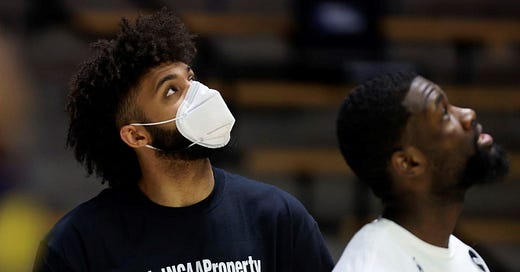NIL Isn’t Nothing, But It’s Not Everything
If you followed the first weekend of March Madness, you may have noticed the #NotNCAAProperty social media protest, a player-lead movement over name, image, and likeness rights, or NIL. The NCAA is heading towards a NIL crisis of one sort or another, thanks to multiple state laws that would prohibit colleges from trying to “unduly restrict” an athlete’s ability to earn money. The first of these laws is scheduled to go into effect in Florida on July 1 of this year, compelling the NCAA to seek uniform rules before then. It seems likely, then, that there could be progress on this issue in the next few months.
But in some ways, the NIL stuff seems like a way of avoiding the real issues involved in compensating college athletes. I understand why the players focus on it—the injustice involved is an easy sell. As Rutgers guard Geo Baker tweeted on the Wednesday before the tournament, “Someone on music scholarship can profit from an album. Someone on academic scholarship can have a tutor service.” But Baker, despite leading his team in scoring in their first tournament win since 1983, cannot take any outside compensation.
The absurdity of the situation was evident in a November story in The New York Times about cheerleaders, who are not governed by NCAA rules, being able to leverage their social media followings into big endorsement deals while players for the teams they cheer for cannot. That college athletes are singularly cut out of the money in college sports strikes most people as unfair.
But it’s important not to let the NIL discussion crowd out the larger issues of player compensation. Lifting the restrictions on NIL compensation is only a small part of what is necessary. The idea that a college musician or tutor can profit of his name or likeness is a nice contrast with college athletes, but it ignores an obvious difference: There is not a multibillion-dollar market for college tutors or musicians. Surely there are people who can put together a nice side hustle with these gigs, but it is not the lucrative industry that college sports is.
There is a version of NIL reform that threatens to turn college athletes into influencers, paid for their brands but not their labor. In this scenario, players could make endorsement deals, but all under NCAA regulations, meaning they could set compensation caps and limit the types of endorsements players make. These are precisely the types of changes that the NCAA is pushing because they would not threaten the status quo. This type of change would also mean very little to most college athletes—it’s not clear what the market for “third party promotional activities” would be for any but the biggest of college sports stars.
The real answer is still to pay players for their labor. And the NIL fight can be a crucial step in that process, if done correctly. The most recent bill introduced in Congress includes an explicit provision for “group licensing.” This would allow for players to license their images as a group, potentially to EA Sports, who had to suspend their NCAA video game series after a player’s lawsuit. (EA Sports did recently announce they were bringing NCAA Football back, which suggests they know something we don’t know.) More importantly, though, group licensing would pave the way for collective bargaining on behalf of the players.
This wouldn’t be a union, technically—the federal government and court system still refuses to recognize college athletes as “employees”—and its precise structure is still unclear. Likely it would be a very constrained kind of bargaining. But giving players a venue to advocate for themselves is the best way to make sure that all are treated fairly. And collective representation of some kind will be necessary to go after the real money in college sports. The NCAA knows this, which is why they are so desperate to fight group licensing.
Ultimately, the money to pay players is going to have to come at someone else’s expense. I suspect that part of the reason the fight for NIL rights is so appealing is that it seems like a solution without any losers: The players are free to get paid by people who want to pay them, without taking money out of anyone else’s pocket. What’s the harm? But, of course, it’s for exactly this reason that NIL rights could be granted without fundamentally altering the power dynamics in the NCAA. A little money in a few players’ pockets is an improvement, but the athletes need to think bigger.



